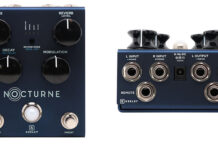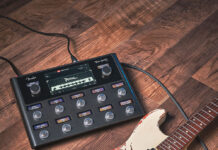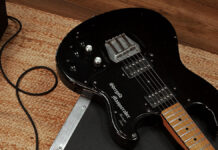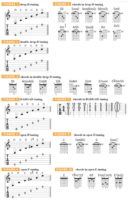
11 Essential Altered Tunings Every Guitarist Should Know
Standard tuning, in which the strings are tuned, low to high, to E A D G B E, has been extensively explored and mined for riffs, licks and chord voicings by generations of guitarists, and while its familiarity is beneficial, in terms of the numerous fretboard shapes and patterns you’ve invested so much time in learning, that can sometimes work against you, as it can be a creative challenge to not keep playing all those same ingrained chords and licks from habit.
In this lesson, I’ll present a broad overview of 10 altered tunings that famous guitarists have employed to great effect in some of their most well-known and celebrated recordings, which can serve as inspiration for your own playing and songwriting endeavors.
A few words about tuning in general: Always use an electronic tuner for any foray into an alternate tuning (and for getting back to standard tuning), but first make an effort to get there by ear, tuning the strings to each other using reference pitches, which may be fretted notes, open strings or any available natural harmonics at the 12th, seventh or fifth frets. (Don’t use fourth-fret harmonics, as they’re slightly flat.) Try to do this quickly and efficiently and zero-in on the precise target pitch before both notes die out. (Think of tuning by ear as playing golf and always try to get a “hole in one.”)
After you’ve made your best effort at tuning your strings by ear, use your electronic tuner to verify the accuracy of the results and to fine-tune as needed. Oftentimes strings you haven’t even touched “drift” slightly sharp or flat, due to the changing overall tension and pull on the neck that results from other strings being tightened or loosened. This issue is more common and acute with an electric guitar, with its less massive and thus more flexible neck joint, compared to that of an acoustic.
A unison—a note doubled in the same octave—is the easiest reference pitch to tune to by ear, but an octave, perfect fifth or perfect fourth may also serve this purpose, if you’re experienced enough to know what to listen for. Being able to tune by ear is a critical listening skill and an important part of your development as a guitarist and musician, and making an effort to do this on a daily basis is a very beneficial, ongoing exercise in ear training. But, again, like an accountant using a calculator, always finish the job with an electronic tuner, as playing out of tune is completely unacceptable to a listener in any situation, no matter how casual!
1. DROP-D
This is the most widely used alternate tuning in many styles of popular music, especially rock and metal, and it’s certainly the most convenient to get into from standard tuning. Simply tune your low E string down one whole step (the equivalent of two frets) to D, so that it matches the pitch of your open fourth string, or “middle D,” one octave lower (FIGURE 1). I find that the fastest and easiest way to tune to drop-D is to sound the natural harmonic at the sixth string’s 12th-fret and tune it down to match the pitch of the open fourth string in unison. Zero-in on the pitch match by carefully listening for a gradual slowing of the “beating,” or pulsating, sound until it stops, or becomes imperceptibly slow.
Drop-D tuning offers a deep, pleasingly resonant sound for riffs built around a first-position D chord, using all six strings, and also makes for a compact, movable root-fifth-octave power chord shape, formed with a single finger, typically the index, barred across the bottom three strings, which provides a perfect foundation for “stacking” a variety of “taller” and more harmonically sophisticated chord voicings upon the basic power chord, a few of which are illustrated in FIGURE 2. Well-known examples of songs that make great use of drop-D tuning include “Everlong” by the Foo Fighters, the Beatles’ “Dear Prudence,” “Spoonman” and “Black Hole Sun” by Soundgarden, Tool’s “Aenima,” “Them Bones” and “Dam that River” by Alice in Chains and Nirvana’s “All Apologies,” the latter three songs all being in drop-D tuning transposed down one half step (low to high, Db Ab Db Gb Bb Eb).
2. DOUBLE DROP-D
Used famously by Led Zeppelin’s Jimmy Page in “Going to California,” Neil Young in “Cinnamon Girl,” Robbie Krieger in the Doors classic, “The End” (pitch shifted approximately 50 cents, or a quarter tone, flat) and Puddle of Mudd’s Wes Scantlin in “Drift and Die,” double drop-D tuning is, as its name suggests, like regular drop-D, but additionally has the high E string tuned down to D (see FIGURE 3). A convenient way to get a reference D pitch to tune your high E string down is to sound the D natural harmonic on your fourth string’s 12th fret. But if you find that tuning a regular note to a harmonic like this is too difficult to hear and judge due to the difference in tone, you can instead use the D note on your B string’s third fret as a reference pitch. You’ll just need to pick and hold both that note and the open high E note, then reach over to tune the latter down to D with your pick hand.
With three open D strings—“low, middle and high”—this tuning is great for crafting drone-y riffs and accompaniments in D major or D minor and presents opportunities to easily finger lush-sounding chord voicings, like those shown in FIGURE 4. And having your middle four strings still tuned normally can be a big plus too when it comes to embellishing a chord shape with “extensions” or playing melodic riffs using familiar shapes.
3. DADGAD
A widely used tuning among masters of fingerstyle acoustic guitar, such as Pierre Bensusan, Phil Keaggy, Martin Simpson and Guitar World Wood Vibrations columnist Mike Dawes, DADGAD takes double drop-D a step further, by additionally lowering the guitar’s B string a whole step, to A (see FIGURE 5). The result is an ethereal and unresolved-sounding Dsus4 chord, with three open D notes in different octaves, two As and a G, the latter of which guitarists often use as their main melody-playing string in this tuning, with the other strings often serving as open-string drones and convenient same-fret octave shapes.
Probably the most celebrated example of a song in DADGAD tuning is the Led Zeppelin classic “Kashmir,” in which Jimmy Page made brilliant use of open strings in conjunction with shifting two-note fretted shapes, especially during the song’s signature descending sus4-3 chord riff heard between the verses, for which he simply moved alternating two-finger shapes down the fretboard to lower positions while incorporating ringing open strings as common tones in each voicing, as shown in FIGURE 6. Page had previously used DADGAD tuning for “White Summer” (with the Yardbirds) and “Black Mountain Side,” the latter transposed down a half step (low to high, Db Ab Db Gb Ab Db).
Another well-known song performed in DADGAD tuning, in this case with a capo at the third fret, is the Soggy Bottom Boys’ arrangement of “I Am a Man of Constant Sorrow,” which was featured prominently in the 2000 film O Brother, Where Art Thou? And fans of the television series Sons of Anarchy are well familiar with the show’s opening theme song, “This Life,” which features swampy guitar parts crafted by Velvet Revolver guitarist Dave Kushner and performed by Curtis Stigers & the Forest Rangers in DADGAD tuning, with a capo at the fourth fret.
4. OPEN D
Lowering the open G string, the sus4, from DADGAD tuning, by a half step, to F#, results in a deep-and warm-sounding open D major chord and tuning, voiced, low to high, D A D F# A D, or root, fifth, root, major third, fifth, root (see FIGURE 7). Due to the strings’ relaxed tension and signature interval stack—a root-fifth-octave power chord on the bottom three strings and a first-inversion major triad (3-5-1) on the top three—open D tuning is ideal for playing slide on acoustic guitar, with its thick, tight strings. This was one of blues legend Elmore James’ favorite tunings, which he used famously on “Dust My Broom” and other songs.
The Rolling Stones’ Keith Richards employed open D tuning in a non-slide context on the original studio version of “Street Fighting Man,” barring his index finger across all six strings to create a movable major barre chord shape, which he then embellished harmonically and melodically with two-finger “extensions” to create rich-sounding major add9 and sus2-4 voicings, like those illustrated in FIGURE 8. Nearly three decades later, Jerry Cantrell employed open D tuning, transposed down a half step (low to high, Db Ab Db F Ab Db) rather resourcefully in the Alice in Chains song “Over Now,” similarly employing his fret-hand index finger to form shifting full major barre chords across all six strings, to which he then added single-note embellishments, on one string at a time, with his other available fingers.
5. OPEN E
Once solidbody electric guitars, with their slinkier strings, became popular in the mid twentieth century, many great slide players, such as Duane Allman and Derek Trucks, adopted open E tuning—low to high, E B E G# B E—as their primary tuning for slide playing. (Trucks plays in open E pretty much exclusively, even when not using a slide.) Open E tuning has the same signature interval stack as open D, only a whole step higher, as if you placed a capo at the second fret in open D tuning, and its open strings give you what would normally be a first-position E chord in standard tuning, as shown in FIGURE 9.
Open E tuning feels tighter than open D, which increases the pull on the neck, causing it to bow more than it would in open D tuning, or even standard tuning, and you run a higher risk of breaking a string in open E tuning, especially on an acoustic guitar. Despite these potentially problematical issues, open E tuning has also been explored and exploited by acoustic players in such folk and rock classics as “Little Martha” by the Allman Brothers Band (both Duane Allman’s and Dickey Betts’ guitars were tuned to open E for this acoustic duet), “Jumpin’ Jack Flash” by the Rolling Stones and “She Talks to Angels” by the Black Crowes. And singer David Lee Roth wrote and played the acoustic guitar intro to the Van Halen song “Ice Cream Man” in open E tuning, transposed down a half step (low to high, Eb Ab Eb G Bb Eb). FIGURE 10 shows a few particularly nice chord voicings in open E.
6. OPEN G
Another popular altered tuning among acoustic and electric guitarists, for both its appealing sound and relaxed feel, in terms of string tension, is open G: low to high, D G D G B D (see FIGURE 11). Keith Richards wrote the riffs to some of the Rolling Stones’ most beloved and enduring songs in this tuning, such as “Honky Tonk Women,” “Brown Sugar,” “Can’t You Hear Me Knockin’,” “Start Me Up” and “Tumbling Dice,” the latter performed with a capo at the fourth fret. Jimmy Page put open G tuning to great use in “Dancing Days,” “That’s the Way” and “Bron-Y-Aur Stomp,” the latter two on acoustic guitar, transposed, respectively, down a half step—low to high, Db Gb Db Gb Bb Db—and a whole step, to what may alternatively be thought of as open F—low to high, C F C F A C). The Black Crowes’ Rich Robinson employed open G tuning, down a half step, on “Jealous Again” to craft the song’s catchy, rocking and very Stones-like electric guitar riffs.
Like open D and open E tuning, open G offers a pleasing major-chord note stack across all six strings at any given fret, with a triad on the top three strings that likewise makes it great for both slide playing and chord riffing with notes added to the index-finger barre by the other fingers. But open G has a distinctly different character than open D or E, due to its different voicing structure, with a low-to-high intervallic spelling of fifth, root, fifth, root, third, fifth. This gives you a root-position major triad—1-3-5—across the top three strings and the fifth of the chord on the bottom, below the fifth-string root note. Interestingly, Richards opted long ago to remove the sixth string from his open-G-tuned Fender Telecaster and play his riffs on only five strings, with the lowest one, now the fifth string, tuned to G, always giving him the root note of the chord he’s playing, which allows him to strut and dance around on stage and perform his riffs live with almost reckless abandon, without ever having to worry about inadvertently sounding any unwanted subroot notes. FIGURE 12 illustrates a few nice chord moves in open G tuning.
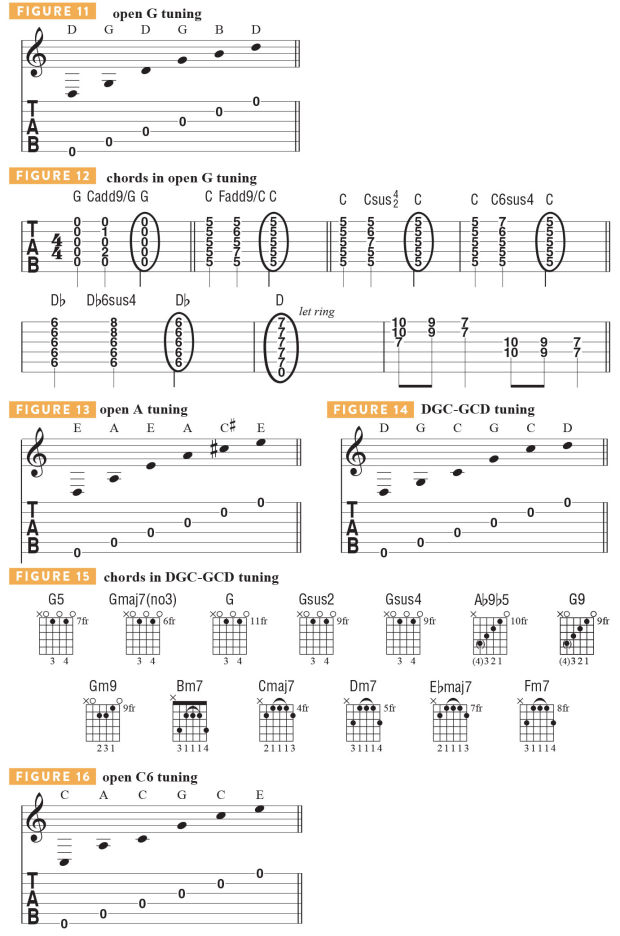
7. OPEN A
Open A tuning (low to high, E A E A C# E) is to open G what open E tuning is to open D—the same thing a whole step higher and, similarly, for many players, its electric-guitar counterpart (FIGURE 13). With the strings unfretted, open A tuning gives you a voicing identical to a first-position A chord in standard tuning, with the D, G and B strings all raised a whole step to E, A and C#, respectively. Delta blues legend Robert Johnson played in open A tuning often, on songs like “Cross Road Blues,” “Traveling Riverside Blues” and “Come on in My Kitchen,” although, since some of his recordings were sped up in the mastering process (intentionally or not), his guitar may have actually been tuned down a half step on some of these songs, to open A flat (low to high, Eb Ab Eb Ab C Eb) or a whole step, to open G.
Many other blues masters have made great use of open A tuning on electric guitar in several of their songs, for both their slide playing and non-slide fingerpicked riffs. Well-known examples include John Lee Hooker’s “Boogie Chillen” and Johnny Winter’s “Mean Town Blues.” Jimmy Page employed open A (in this case, with a slow phase-shifting effect) for his swampy slide-guitar tour de force, Led Zeppelin’s “In My Time of Dying,” as did Jack White on the White Stripes hit “Seven Nation Army,” which, interestingly, is in the key of E minor, not A major.
8. DGC-GCD (“THE RAIN SONG”)
Like DADGAD, this is an enigmatic-sounding tuning that has an unresolved quality to it, in this case giving you what may be thought of as a Csus2/D (Csus2 over D) chord (FIGURE 14). I can only think of one famous song that uses this unusual tuning, but it’s a masterpiece that’s definitely worth learning if you’re an altered-tuning enthusiast and adventurous songwriter/composer, “The Rain Song” by Led Zeppelin. FIGURE 15 illustrates a few of the shimmering chord voicings Page employs in this song. Note the liberal use of open-sting drones, unisons, octaves and parallel movable shapes.
9. OPEN C6
Another tuning that Jimmy Page made brilliant use of is open C6 (low to high, C A C G C E), for which the A, G and high E strings are all tuned normally, the low E and D strings both drop down to C and the B string goes up to C, as shown in FIGURE 16. The guitarist employed this tuning on two acoustic Led Zeppelin classics, “Friends” and “Bron-Yr-Aur” (both recorded during the Led Zeppelin III sessions). In “Friends,” Page took advantage of the familiar two-finger strummed octave shape on the A and G strings to play stand-out melodies up and down the fretboard in conjunction with the three ringing open C strings, similar to FIGURE 17. More recently, Marcus Mumford employed open C6 tuning on two of his band Mumford & Sons’ biggest hits, “I Will Wait” and “Little Lion Man,” the latter song performed with a capo at the fifth fret.
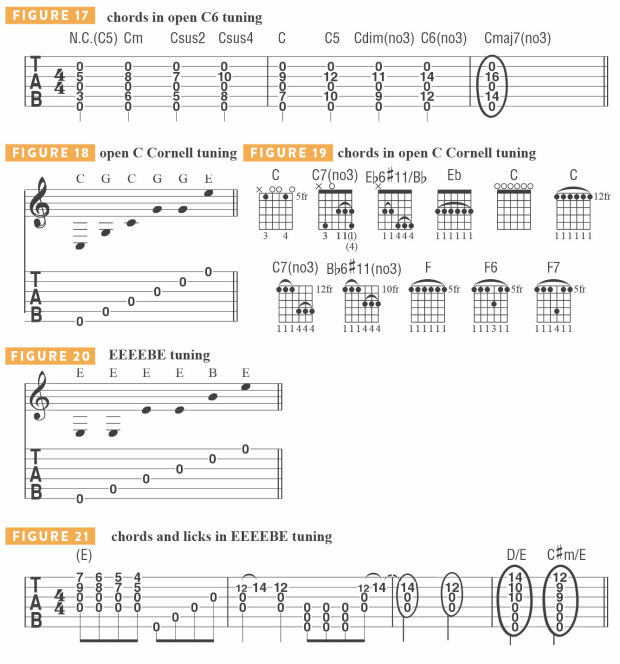
10. OPEN C-CORNELL
Our next tuning is one employed by the late, great singer-songwriter and guitarist Chris Cornell for two of Soundgarden’s biggest hits, “Burden in My Hand” and “Pretty Noose.” It’s a variation on open C tuning (low to high, C G C G C E), for which the B string, instead of being tuned up to C, is instead tuned down to G, in unison with the G string, as shown in FIGURE 18. This unison doubling makes notes played together on those two strings at the same fret, or open, really stand out. FIGURE 19 illustrates a few of the unique chord voicings Cornell employed with this tuning in “Burden,” some of which he also used in “Pretty Noose.”
11. EEEEBE TUNING
The 11th tuning is unusual but worth checking out. It’s what’s often referred to as Bruce Palmer modal tuning, named after its inventor, the late Buffalo Springfield bassist Bruce Palmer, who was also a talented guitarist. With this tuning, the low E, high E and B strings are tuned normally. The A string then goes down to match the low E, the D string goes up to E, and the G string goes down to E, in unison with the “middle E” string. The result is a drone-y, mystical-sounding E5 chord (FIGURE 20).
Stephen Stills employed this tuning to great effect to craft his sitar-like acoustic guitar parts in the classic Crosby, Stills & Nash song “Suite: Judy Blue Eyes,” as well as those in “4+20” and “Carry On” with Crosby, Still, Nash & Young. In “Suite: Judy Blue Eyes,” Stills used his normally tuned B and high E strings as his main melody-playing strings, with the bottom four strings employed primarily as accompanying unison and octave drones, as in FIGURE 21. Interestingly, Stills employed this same tuning scheme, transposed down two whole steps (!), in “Love the One You’re With,” with his acoustic guitar tuned, very unusually, to C C C C G C, low to high. (You’ll want to use thick strings for this tuning.)
Hopefully, This list of altered tunings and the artists and song examples cited above have given you some useful points of reference and creative inspiration to experiment with twisting your guitar’s tuning pegs to these nonstandard settings. There are, however, many more altered tunings than these 10 that countless world-renowned guitarist-singer-songwriters have employed, including some used in well-known songs by artists like Joni Mitchell, John Rzeznik of the Goo Goo Dolls, Coldplay’s Chris Martin and Smashing Pumpkins mastermind Billy Corgan.
When experimenting with altered tunings and searching for new sounds, a good approach is to drop or raise any one or two strings and listen to what happens when you go to play familiar chord shapes. You may encounter some awful sounds along the way, but you’re just as likely to discover a few gorgeous, majestic chord voicings that could spark the writing of a fresh-sounding original song.
Source: www.guitarworld.com

